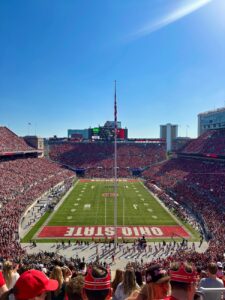Draining Lake Powell is nothing but a pipe dream
This archived article was written by: Austin Palmer
About 40 years ago, the floodgates on the Glen Canyon Dam were closed. As they swung into place beneath the 710-foot-tall dam, the waters of the Colorado River began to spread and form pools. About 17 years later, those small pools had transformed into one huge reservoir. In fact, Lake Powell is the second largest man-made body of water in the United States. At capacity, Lake Powell holds nearly 30 million acre-feet of water (an acre-foot is about as much water as it would take to cover a football field with one foot of water).
For most of us, the quantity of water stored behind the Glen Canyon Dam holds little significance, but what we can do on the water is much more important. For many students, Lake Powell is an attractive and oft visited vacation spot. Now, nearly 40 years after the completion of the dam, environmental groups are campaigning to pull the plug and drain Lake Powell. It is our responsibility as conscientious students and citizens to become informed about the issues involved in this debate and to put an end to what has become a monumental pipe dream for environmentalists.
Outlining the entire debate would take up hundreds of pages, so we will just stick to a condensed version of some of the most important issues involved. Those in favor of draining Lake Powell claim that the dam has destroyed an entire ecosystem, is pointless in terms of water storage and energy production and has flooded hundreds of miles of pristine wilderness country. While some of these arguments are based on facts, they only tell one side of the story.
After the Glen Canyon Dam was built, the ecosystem below the dam changed dramatically. Native plant species were stranded high above the river banks and since the floods that normally spread the seeds no longer occur, these plants aren’t able to reseed themselves and are being replaced by nonnative species. The same can be said of various species of fish. The river temperature has dropped by nearly half and is able to support nonnative species of trout that are seriously threatening the native species.
All of the species that are being driven out still exist above the dam but that is not something that the environmentalists want everyone to realize. Furthermore, the diversity of wildlife that exists below the dam today is much greater than before the dam was built. There are over 50 bald eagles in the area and the number of peregrine falcons has skyrocketed since the completion of the dam due to a reliable source of food that exists. These are just two of the many species that have been benefitted. They would not even be there if the dam had not been built.
Aside from the ecological damage the dam has caused, environmentalists argue that Lake Powell is not needed or even effective as a water-storage facility. This argument is either misunderstood by the opposition or they think that the public does not understand what would happen if Lake Powell were drained. To put it simply, the Colorado River Compact was signed in 1922 which divided the Colorado River into two parts; the upper and lower basins.
The upper basin includes the states of Utah, Wyoming, Colorado and New Mexico. The lower basin states include Arizona, Nevada and California. Under this agreement, both the upper and lower basins receive 7.5 million-acre feet of water each year from the Colorado River.
Here’s the kicker: the lower division states have priority over the upper basin states in terms of water usage. What that means is that we are required to let 7.5 million acre feet of water down the river to Lake Mead every year, even if we have to give them all or a portion of our share. In years of drought, Lake Powell acts as a storage facility so that we can still release the required quantity without putting water restrictions on the states in the upper basin. This would not be possible if Lake Powell were drained and when we experience another serious drought, we would literally be forced not to use our portion of the water but rather, would be obligated to let it make its way down to the lower basin states.
Aside from providing us with insurance, Lake Powell produces clean power from its hydroelectric generators. If this source of electricity were no longer available, those who rely on it would have to find an alternative source of power. The alternatives are much more harmful and destructive to the environment.
For many of you, the loss of an awesome recreational area is the greatest concern. Millions of people visit Lake Powell and the Glen Canyon Recreation Area every year. The whole base of Paige, Arizona’s economic foundation is based on Lake Powell and other tourists. Tourist revenue generates half a billion dollars for Paige annually. If Lake Powell were drained Paige, would literally wither up and blow away.
It just doesn’t make sense to drain the lake. Consider this, before Lake Powell existed the number of visitors in the area did not even reach a fraction of what they are today. The very existence of Lake Powell draws visitors to the area, not only those who entertain themselves on the water but those who enjoy hiking, repelling and other outdoor activities. Lake Powell only covers 13 percent of the Glen Canyon Recreation Area and that obviously leaves nearly 90 percent for those who prefer climbing around among the rocks to playing in the water.
While it is true that the environment has changed since the Glen Canyon Dam was built and Lake Powell filled, the benefits that have been derived from it far outweigh the oppositions reasons for wanting to drain it. The environment is much healthier and diverse than it has ever been and we are allowed access to some of the most beautiful country on Earth. For those who are in favor of draining Lake Powell, this fantasy will only come to life when their heads hit their pillows at night. For more information on this subject, visit www.lakepowell.org/ on the Internet for a more detailed discussion on the pros and cons involved in the controversy.




